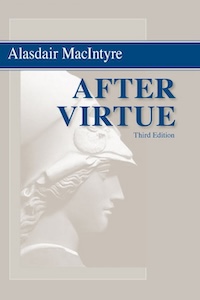After Virtue, Chapter 5
31 Oct 2025

After Virtue: A Study in Moral Theory, Third Edition
Alasdair MacIntyre
University of Notre Dame Press, 1981, 2007
Chapter 5 - why they failed
All of these figures were attempting to move from a concept of human nature (i.e., his rationality, his passions, his ability to choose) to an ethics.
contrast with key elements of traditional/classical ethical scheme:
1. Essential human nature (untutored)
2. Potential/ideal human nature (telos)
3. Means of moving 1 to 2 (rules/precepts of ethics)
…which remains consistent even through Christian, Jewish, or Islamic revisions in the middle ages
Protestant reformers changed the status of (2) — man’s power of reason [i.e., ability to discern telos] was corrupted by the fall; reason is powerless to correct passions (Hume has a Calvinist heritage) — we can only discern telos via divine revelation. This sets the stage for eventual rejection of teleology via the rejection of both Christian theology and Aristotelianism, which we see in Hume, Kant, Kierk. and which is exactly why the project failed (like sawing a leg off a 3-legged stool and then wondering why it doesn’t stand up).
AM assesses Enlightenment thinkers, and how aware they were of this — Kant, the winner, (inconsistent with his own theory) admits that w/o teleology, morality is unintelligible.
This is how the is/ought “problem” arose - and the “problem” of new terms appearing in conclusion not present in premises. These “problems” are overcome with the re-introduction of functional concepts. Functional concepts (e.g., “watch” or “farmer”) include a purpose or function which enables evaluation (e.g. watch doesn’t tell time correctly; therefore bad watch). In Aristotelianism, “man” is a similarly functional concept - enables ethical statements to be factual.
The loss of functional concepts has radically changed language and usage, impoverished our moral discourse, creating confusion and ambiguity (what is the status of moral statements, since they cannot be factual?)
This turn can also be seen historically. Many consequences, most importantly in new conceptions of the “self.”